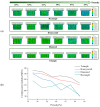Structural Mechanical Properties of 3D Printing Biomimetic Bone Replacement Materials
- PMID: 37092418
- PMCID: PMC10123638
- DOI: 10.3390/biomimetics8020166
Structural Mechanical Properties of 3D Printing Biomimetic Bone Replacement Materials
Abstract
One of the primary challenges in developing bone substitutes is to create scaffolds with mechanical properties that closely mimic those of regenerated tissue. Scaffolds that mimic the structure of natural cancellous bone are believed to have better environmental adaptability. In this study, we used the porosity and thickness of pig cancellous bone as biomimetic design parameters, and porosity and structural shape as differential indicators, to design a biomimetic bone beam scaffold. The mechanical properties of the designed bone beam model were tested using the finite element method (FEM). PCL/β-TCP porous scaffolds were prepared using the FDM method, and their mechanical properties were tested. The FEM simulation results were compared and validated, and the effects of porosity and pore shape on the mechanical properties were analyzed. The results of this study indicate that the PCL/β-TCP scaffold, prepared using FDM 3D printing technology for cancellous bone tissue engineering, has excellent integrity and stability. Predicting the structural stability using FEM is effective. The triangle pore structure has the most stability in both simulations and tests, followed by the rectangle and honeycomb shapes, and the diamond structure has the worst stability. Therefore, adjusting the porosity and pore shape can change the mechanical properties of the composite scaffold to meet the mechanical requirements of customized tissue engineering.
Keywords: 3D printing; PCL; TCP; bone scaffold; finite element method; mechanical property analysis.
Conflict of interest statement
The authors declare no conflict of interest.
Figures












References
-
- Glowacki J. The Law of Bone Remodelling. Plast. Reconstr. Surg. 1988;82:717. doi: 10.1097/00006534-198810000-00036. - DOI
Grants and funding
LinkOut - more resources
Full Text Sources

